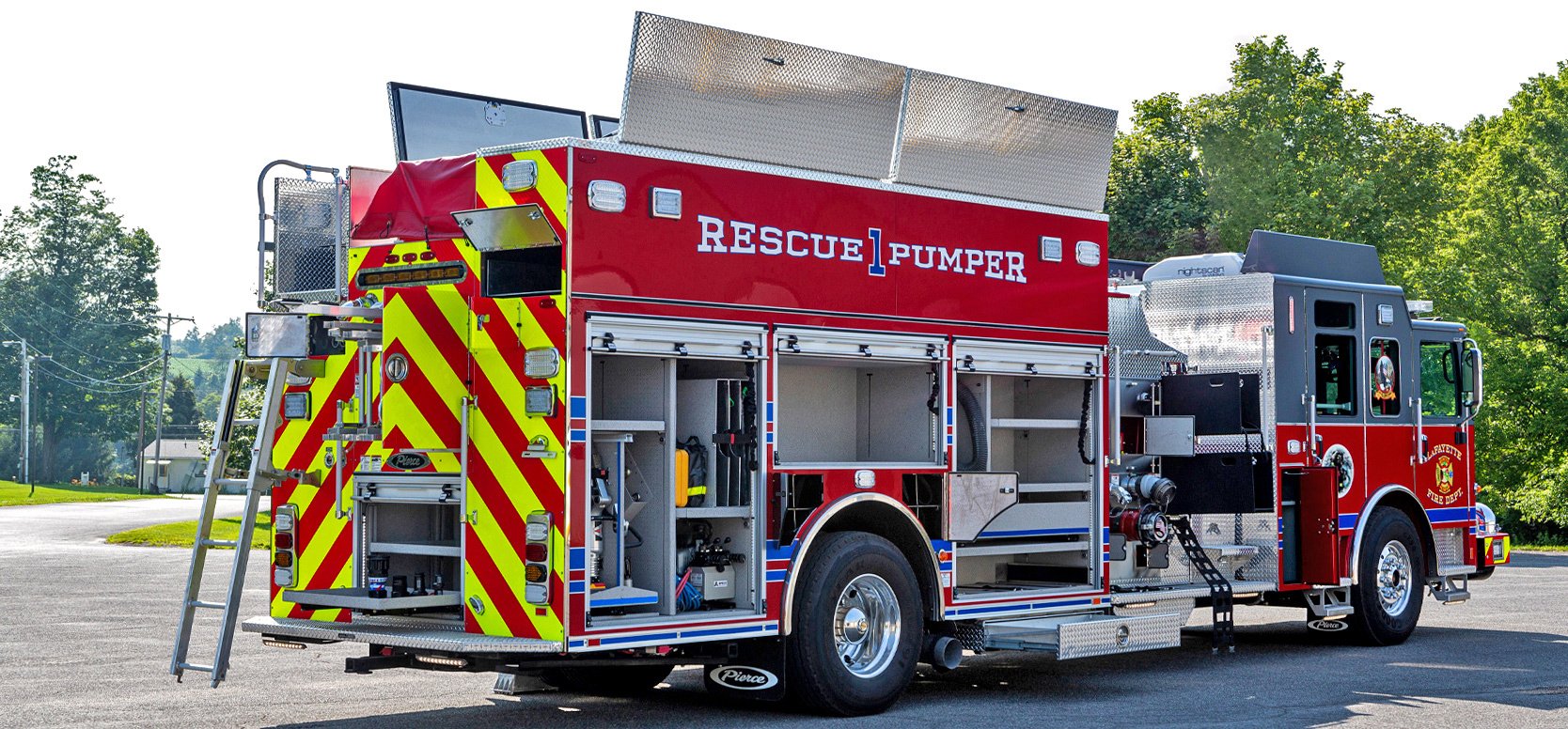
When a fire department is designing a new fire truck, there are so many options, components and features to consider. Use this blog post as a guide to help make one decision a little bit easier—fire truck top access options.
Below, we offer a detailed comparison of several top access options for pumpers, rescues and aerial fire trucks to help you determine what might be the right fit for your fire department based on the mission of your new apparatus.
What Do Firefighters Need to Access on Top of a Fire Truck?
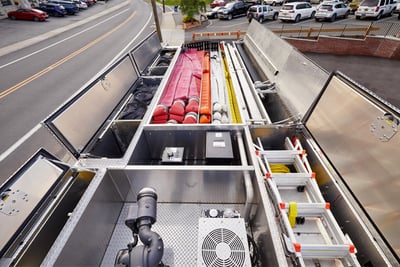 Space is a valuable commodity on a fire truck, which is why with many truck configurations, the top of the truck is used strategically.
Space is a valuable commodity on a fire truck, which is why with many truck configurations, the top of the truck is used strategically.
What might you find on top of an apparatus?
Hosebed
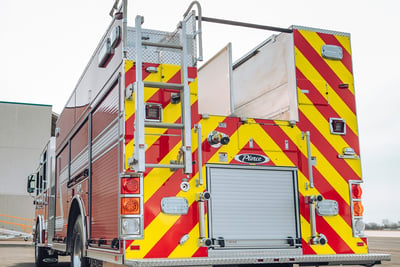 The National Fire Protection Association (NFPA) 1901 Standard has requirements for hose storage depending on the type of fire truck and pumping capabilities. For pumpers, and many aerials, the hose storage area is a hosebed on the top of the truck.
The National Fire Protection Association (NFPA) 1901 Standard has requirements for hose storage depending on the type of fire truck and pumping capabilities. For pumpers, and many aerials, the hose storage area is a hosebed on the top of the truck.
Hatch Compartments
Many departments also utilize the top of a fire truck for hatch compartment storage. Hatch compartments are typically found on the outboard sides of the truck.
Large Tool and Ladder Storage
Fire departments also use the top of the truck to strategically store items that are required on board but seldom used, or for large tool or equipment storage. These items may include extra ground ladders, foam pails and hose packs.
An Aerial Device
An aerial device sits on the top of a truck and includes a turntable, ladder and in some cases, a platform.
Top access is critical to deploy an aerial platform, repack hose after a call and quickly access any tools or equipment stored in the hosebed or hatch compartments. Depending on the type of fire truck a fire department is considering, several top access options are available.
Determining what is suitable for your fire department can often depend on the truck’s mission, firefighter preference, current fleet standards, and the common types of incidents in your geographic location.
Pumper Fire Truck Top Access Options
Accessing storage areas and hosebeds on top of a pumper fire truck can be achieved in several different ways.
Folding Steps
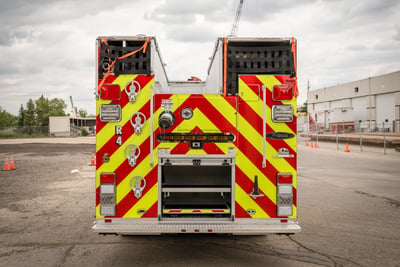 Folding steps are a very traditional, space-saving, flexible and economical option for easy access to the top of a fire truck.
Folding steps are a very traditional, space-saving, flexible and economical option for easy access to the top of a fire truck.
- Folding steps are constructed of durable materials and most designs include handhold cutouts in every step reducing the need for additional handrails.
- These versatile steps fold up against the body of the truck reducing the overall footprint and saving valuable space.
- Strategic placement means folding steps can easily fit around other components or lighting on the side or rear of the apparatus, allowing for more usable space on the fire truck.
Wedge and Corner Steps
These steps are custom made by Pierce for our customers to meet the unique needs of our customers’ trucks.
- Highly customizable steps include handhold cutouts to reduce the need for additional handrails.
Ladder Options
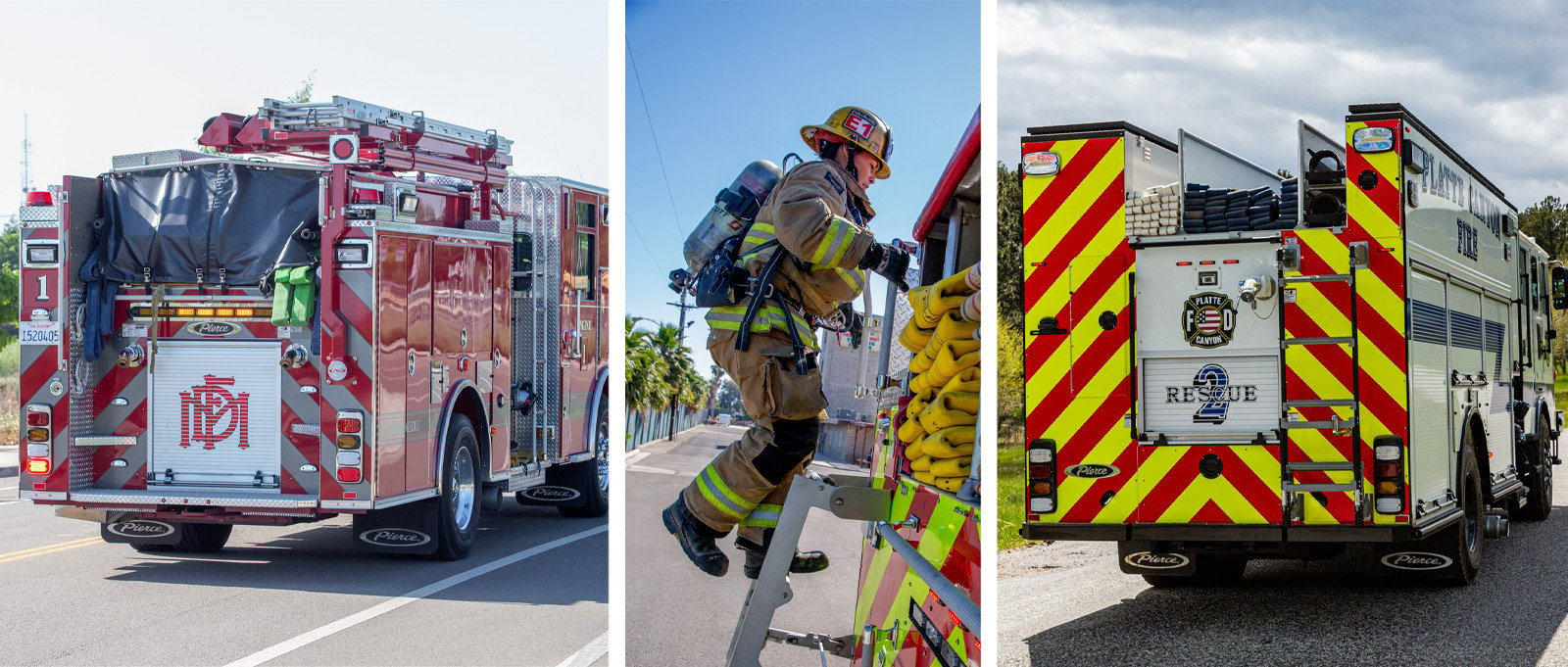
In recent years, there has been an increase in the number of departments integrating ladder access options on new pumper fire trucks. Ladders are mounted or bolted to one of the rear bulkheads.
Fire departments may choose a ladder option because it is easier to maintain a sense of stability when climbing versus built-in or folding steps. Moreover, passing equipment down from the top is often easier with ladder access because firefighters can retain three touch-points easier as they work and can lean into certain versions of ladders that are inclined, increasing stability. Ladders, however, require a larger footprint on the apparatus and may limit lighting and certain storage compartment options.
There are several types of top access ladder options available.
Fixed Ladders or Swimming Pool Ladders
Fixed ladders, often referred to as swimming pool ladders, are stationary with a basic curved-top design offering firefighters a vertical climb option. The simple, familiar design makes these a great option for ease of use.
Partial Swing-Out Ladder
A partial swing-out ladder stows in a totally vertical position and swings out and away from the truck at the bottom when deployed for use. When the ladder is needed, a release mechanism is pulled to swing the ladder out and allow the bottom rungs to swing down. A lock holds the ladder in this position until it is stowed. Since this type of ladder is angled when deployed, it has a more comfortable feel than a fixed vertical ladder. It cannot be climbed in the stowed position.
PUC-Style Ladder
A PUC-style ladder is a unique Pierce Manufacturing design that was originally created for the PUC fire truck but because of popularity and interest, is now available on additional truck types.
A PUC-style ladder is different from a fixed or swing-down ladder because it extends at an angle, creating a more natural and stable ascent and descent for firefighters. Its simple mechanical design results in years of easy and dependable service. In its stowed position, it requires a smaller footprint than most other ladders.
Heavy-Duty Rescue Fire Truck Top Access Options
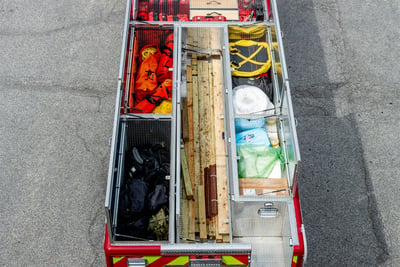 Heavy-Duty Rescue (HDR) fire trucks have several unique top access options that are not typically found on other types of apparatus; these include, slide-out ladders, slide-out staircases, and built-in staircases. These top access options are primarily found on non-walk-in rescues because walk-in rescues typically do not have hatch boxes on top of the vehicle.
Heavy-Duty Rescue (HDR) fire trucks have several unique top access options that are not typically found on other types of apparatus; these include, slide-out ladders, slide-out staircases, and built-in staircases. These top access options are primarily found on non-walk-in rescues because walk-in rescues typically do not have hatch boxes on top of the vehicle.
Heavy-Duty Rescue Top Access Ladder Options
Fire suppression is not a common feature on a heavy-duty rescue, so saving space at the top of the truck for a hosebed is often unnecessary. As a result, there is usually a walkway with hatch compartments on both sides. There are several choices of roof access on these non-walk-in style units.
Slide-Out Ladder
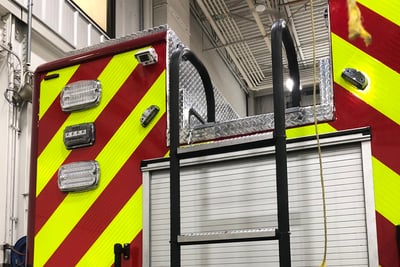 A slide-out ladder features a simple and easy-to-use design. The ladder pulls down from a stowed position in the walkway at the top of the fire truck, and slides down to a fixed position on the tailboard. The center-mount design does not impede other items on the rear bulkheads such as rope eyes and lights.
A slide-out ladder features a simple and easy-to-use design. The ladder pulls down from a stowed position in the walkway at the top of the fire truck, and slides down to a fixed position on the tailboard. The center-mount design does not impede other items on the rear bulkheads such as rope eyes and lights.
Some fire departments prefer the sleek and simple design of a slide-out ladder, while others do not like that it blocks the rear storage compartment when deployed. Others may not care for the vertical climb required on a ladder. In either case, a slide-out staircase may be a better option.
Slide-Out Staircase
A slide-out staircase is ideal when large or heavy items are stored on top of the truck. Like a slide-out ladder, a slide-out staircase is stowed in the walkway in a collapsed position and is pulled down using a roller system.
When deployed, the slide-out ladder includes handrails for easy ascent and descent. The deployment angle also means that compartments behind the ladder are accessible on the scene. Moreover, accessing heavy items from the top of the truck is easier when you have the added support of handrails and a more ergonomic climbing position. The one potential drawback of a slide-out ladder is that it is heavy, making it a two-person operation to deploy and stow.
Built-in Staircase
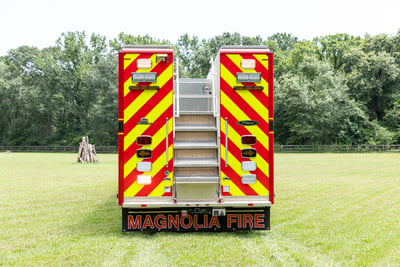 A built-in staircase is part of the structure of the sheet metal on a fire truck and is positioned in the rear center. While it does remove some usable storage space, a built-in staircase is a great option for HDR trucks since access to the roof hatch compartments is easier than with a ladder. Perhaps the greatest benefit of a built-in staircase is that the compartments are always accessible. A built-in staircase has three design options that fire departments can consider: built in single stair compartments, two-step and three-step options.
A built-in staircase is part of the structure of the sheet metal on a fire truck and is positioned in the rear center. While it does remove some usable storage space, a built-in staircase is a great option for HDR trucks since access to the roof hatch compartments is easier than with a ladder. Perhaps the greatest benefit of a built-in staircase is that the compartments are always accessible. A built-in staircase has three design options that fire departments can consider: built in single stair compartments, two-step and three-step options.
Built-in single stair compartments feature a compartment in every step of the staircase. This allows for strategic tool storage and the ability to capitalize on every available cubic inch of space. Individual compartment size is based on the chosen stair riser height. The NFPA sets the maximum stair height at 18 inches, so fire departments can add more, or fewer stairs based on their climbing preferences. While a built-in staircase with individual stair compartments is a great option for small tools and equipment storage, fire departments need to thoroughly consider the size of items that can fit in these smaller compartments. Once designed and built, the compartment size is fixed which may make it difficult to store different equipment if the mission of the truck changes.
A two-step staircase offers more storage space because two steps combine together with a hinged top to create a larger storage compartment. Gas struts hold up the hinged stairs and pull-down straps makes it easy for one firefighter to open and close.
A three-step staircase has a fixed lower step and the three remaining steps hinge together to create one large compartment. The full-height storage space is much more versatile for tool and equipment storage. The three-step staircase also features gas struts to hold the compartment open and a pull-down strap for opening and closing.
When it comes to fire truck top access options, there are many options to consider. Determining the mission of a fire truck and the type of support it will provide in your community can help determine the most suitable option for your department.
Top Access Options for Aerial Fire Trucks
Just like pumper and rescue trucks where top access is reserved for a hosebed, crosslays, tools and equipment, top access for an aerial apparatus is also used to access the turntable and aerial device.
Pierce Manufacturing’s aerial apparatus top access ladder options are all custom-engineered to maximize functionality in a compact design.
NFPA regulations require all aerial apparatus to include one point of access from the ground to the turntable for the turntable operator. How this is achieved is quite different for rear mount and mid-mount aerials.
Rear-Mount Aerial Top Access Options
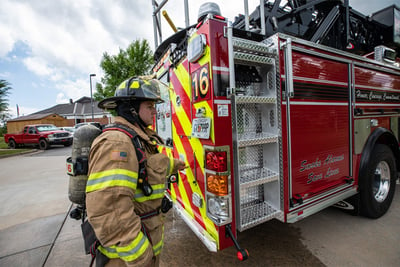 Two access options are available on a rear mount aerial apparatus: folding steps and a unique, custom-built pull-out drop-down ladder.
Two access options are available on a rear mount aerial apparatus: folding steps and a unique, custom-built pull-out drop-down ladder.
The pull-out, drop-down ladder is designed to fit flush to the body of the apparatus in a stowed position. It features a pull-out, drop down ladder followed by flat steps for increased foot stability. The ladder also includes handholds for balanced climbing. A firefighter can easily pull out the ladder and climb to access the turntable platform.
Understandably, there is no access option to the platform on a rear mount with the platform hanging over the cab. Instead, the aerial device can be maneuvered down to the ground to access the platform.
Mid-Mount Aerial Top Access Options
On a mid-mount aerial, like the Pierce Ascendant® 100' Heavy-Duty Aerial Tower, three access points are always included: one access point to the turntable in the middle of the fire truck, and two access points at the rear of the platform.
The side access point for the turntable features a ladder similar to that used on the rear mount aerial, with a pull-out, drop-down ladder. The ladder includes handholds and flat rungs for ergonomic climbing.
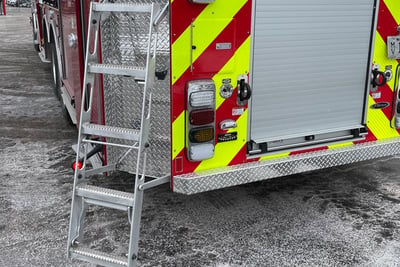 At the rear of the truck, the ladder access is uniquely engineered by Pierce. The rear-access pull-out ladder on a mid-mount aerial does include a drop-down step, handrails, and a flat rung to improve foot surface area, but the ladder is taller and narrower. The shallower depth of the ladder is designed specifically for the mid-mount to fit into the chambered corners of the body to ensure it does not interfere with the rear tail swing capabilities. The ladder is designed to optimize response time, so firefighters can quickly access the platform and deploy immediately using the platform controls, rather than accessing the turntable and climbing the aerial device to the platform.
At the rear of the truck, the ladder access is uniquely engineered by Pierce. The rear-access pull-out ladder on a mid-mount aerial does include a drop-down step, handrails, and a flat rung to improve foot surface area, but the ladder is taller and narrower. The shallower depth of the ladder is designed specifically for the mid-mount to fit into the chambered corners of the body to ensure it does not interfere with the rear tail swing capabilities. The ladder is designed to optimize response time, so firefighters can quickly access the platform and deploy immediately using the platform controls, rather than accessing the turntable and climbing the aerial device to the platform.
When the aerial is rotated away, firefighters can use the steps to get on and off of the truck. The steps can also allow for access to the hosebed and equipment mounted on the truck.
As you consider your next fire apparatus purchase, we hope this blog helped guide you through fire truck top access options with ease.
To learn more about these options, reach out to your local dealer.
Do you currently use any of these top access options? What are the benefits you see for your fire department?